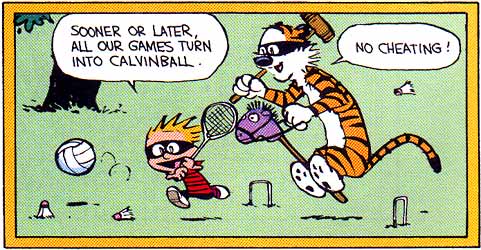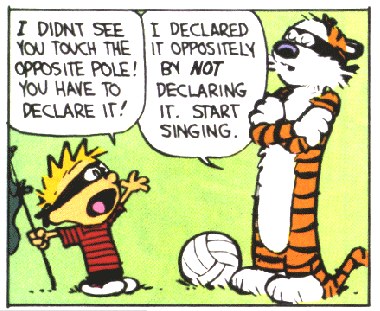SEO: Don’t Believe ALL the Hype
I enjoy Calvinball. Well, I enjoy reading about it.
This is a game played by Calvin, a strong willed kid and his stuffed tiger Hobbes (that to him, is alive). From 1985 to 1995, cartoonist Bill Watterson wrote and illustrated the comic strip Calvin and Hobbes. Since his retirement, his strip lives on in the form of collection books. I have five of them.
Calvinball is a game invented by Calvin that resembles tag, baseball, volleyball and basketball and may involve wickets and mallets. What makes his sport so funny is that…they make up the rules as they play. Sound familiar? Actually there is one rule that does not change: you cannot play Calvinball the same way twice. It is the hilarious arguments Calvin and Hobbes use to bend the rules that make the strip so funny. It is a mirror into my childhood. LOL
Search Engine Optimization (SEO) is basically getting your website to rank high on Google so your audience can find you. (I use Google as the standard because they are the #1 search engine.) At least, this is the popular definition that I have heard from most clients. But don’t believe the hype. Google algorithms are akin to black magic: closely guarded everchanging company secrets known only by a select few. They have some of the smartest engineers, product managers and executives tweaking their algorithms. I bet there are non-disclosure agreements signed before you start at Google and after you leave.
So how does a company/organization score a goal (your audience finding you on the internet) when the rules (algorithms) keep changing?
So, what is SEO…really?
According to whatisseo.com, it is the process of improving the visibility of a website on organic (“natural” or un-paid) search engine result pages by incorporating search engine friendly elements into a website.
Now, notice the above definition is talking about what you can do to your website to reach your audience, not trying to figure out classified algorithms and manipulating page rankings.
This is what it says in the Google SEO Starter Guide:
Search engine optimization is often about making small modifications to parts of your website. When viewed individually, these changes might seem like incremental improvements, but when combined with other optimizations, they could have a noticeable impact on your site’s user experience and performance in organic search results…. Focusing too hard on specific tweaks to gain ranking in the organic results of search engines may not deliver the desired results. Search engine optimization is about putting your site’s best foot forward when it comes to visibility in search engines, but your ultimate consumers are your users, not search engines.
There was a time when you could work the angles when search engines and social media were new. Since then, search engines and social media platforms have improved.
There are SEO companies promising exactly what Google is telling you NOT to do. As a Brand Consultant, I let clients know that the key to reaching their audience via SEO is:
- A mobile friendly website because two thirds of Americans have a smartphone and over 65% use it to access the internet.
- Excellent user centered content (articles, images, memes, videos, etc) that is spread across the internet.
- Utilizing keyword search trends and tools.
- Tethering your company’s/organization’s content to stories driven by established brands.
- Relational strategies (not technical ones) that humanize your approach and reach out to influencers.
- Paid ads (you cannot get around this depending on your audience).
Ultimately, what this is really about is KNOWING your audience. How is your approach to SEO affected if your audience are low income African Americans who prefer texting over email? What about millennials who shop via smartphone? How does your audience’s tastes factor into your website design, graphics and content?
SEO is a tool in the branding process. To chase after page rankings and algorithms is missing the point because the goal posts will continue to be moved. Updates continue to happen with Google’s algorithms. Although design trends, demographic and psychographic data can change as well, you have a better chance of reaching your audience when you utilize it. Why? These factors are influenced by a variety of things: income, location, ethnicity, technology, history, experiences, etc. Because of this, the change is much slower and creative professionals are sometimes able to even see where things are going. Do this things properly and your audience will find you.
In contrast, Google’s algorithms (goal posts) are in the hands of one entity and can change when they deem necessary. If you want to test my 6 ideas above, analyze a top competitor’s SEO strategy and compare what you find to your own. That’s what I do.
I am not a SEO expert but it is a part of my branding strategies with clients. Also, check out my other Linkedin article: What Marketers Arent Tellin You About Social Media…& It Aint Pretty
So, what have I missed about SEO? What other goal posts are being moved? LOL

Thanks for taking the time to read this article. Your shares, likes and comments are appreciated.
